Performance Comparison of Different Constructed Wetlands Designs for the Removal of Personal Care Products
Abstract
1. Introduction
2. Methods
3. Results and Discussion
3.1. Removal of Widely Studied PCPs by CWs
3.2. Environmental Risk Assessment for the Selected PCPs
3.3. Role of Physicochemical Properties of PCPs and Removal Mechanisms in CWs
| Class/PCPs | Possible Removal Mechanism | References | Dominant Removal Mechanism * |
|---|---|---|---|
| Artificial sweeteners | |||
| Acesulfame | Biodegradation (aerobic) | Kahl et al. [17]; Nivala et al. [18] | Biodegradation (aerobic) |
| Preservatives | |||
| Methylparaben | Plant uptake | Anjos et al. [39]; Petrie et al. [40] | Plant uptake; Biodegradation (aerobic) Photodegradation ** |
| Biodegradation (aerobic) | Matamoros et al. [28,29]; Anjos et al. [39]; Chen et al. [27] | ||
| Photodegradation | Chen et al. [27] | ||
| Hydrolysis | Chen et al. [27] | ||
| Volatilization | Chen et al. [27] | ||
| Propylparaben | Plant uptake | Anjos et al. [39] | Plant uptake; Biodegradation (aerobic) Photodegradation ** |
| Biodegradation (aerobic) | Anjos et al. [39] | ||
| Photodegradation | NA | ||
| Insect repellents | |||
| N,N-diethyl-meta- toluamide | Biodegradation (aerobic) | Li et al. [21]; Sgroi et al. [20] | Biodegradation (anaerobic) ** |
| Biodegradation (anaerobic) | Yi et al. [5]; Sgroi et al. [20] | ||
| Antiseptics | |||
| Triclosan | Adsorption | Carranza-Diaz et al. [41]; Chen et al. [26]; Liu et al. [42]; Xie et al. [43]; Button et al. [44]; Wang et al. [45] | Adsorption; Biodegradation (aerobic); Photodegradation |
| Sorption | Ávila et al. [46]; Vystavna et al. [47] | ||
| Biodegradation (aerobic) | Ávila et al. [22,46,48]; Zhang et al. [11]; Zhao et al. [49]; Chen et al. [26]; Liu et al. [42]; Li et al. [21]; Vymazal et al. [31]; Xie et al. [43]; Button et al. [44]; Chen et al. [27]; Wang et al. [45] | ||
| Biodegradation (anaerobic) | Park et al. [50]; Vystavna et al. [47] | ||
| Photodegradation | Matamoros and Salvadó [51]; Zhang et al. [11]; Ávila et al. [46,48]; Matamoros et al. [28]; Li et al. [21]; Vymazal et al. [31]; Vystavna et al. [47]; Francini et al. [52]; Chen et al. [27] | ||
| Plant uptake | Zhang et al. [11]; Liu et al. [42]; Dai et al. [30]; Li et al. [21]; Vymazal et al. [31]; Francini et al. [52]; Xie et al. [43] | ||
| Triclocarban | Sorption | Zhu and Chen [25]; Vymazal et al. [31] | Sorption ** |
| Fragrances | |||
| Methyl dihydro-jasmonate | Biodegradation (aerobic) | Matamoros et al. [19,28]; Hijosa-Valsero et al. [14,15,53,54]; Reyes-Contreras et al. [16] | Biodegradation (aerobic); Plant uptake |
| Biodegradation (anaerobic) | Hijosa-Valsero et al. [14] | ||
| Plant uptake | Hijosa-Valsero et al. [14,15]; Reyes-Contreras et al. [16]; Salcedo et al. [55] | ||
| Retention processes | Hijosa-Valsero et al. [15] | ||
| Cashmeran | Sorption | Matamoros and Salvadó [51] | Sorption **; Adsorption ** |
| Adsorption | NA | ||
| Galaxolide | Plant uptake | Hijosa-Valsero et al. [14,15]; Reyes-Contreras et al. [16]; Salcedo et al. [55] | Sorption; Adsorption |
| Adsorption | Hijosa-Valsero et al. [14,15]; Reyes-Contreras et al. [16] | ||
| Retention processes | Hijosa-Valsero et al. [15] | ||
| Sorption onto organic surfaces | Matamoros and Bayona [56]; Matamoros et al. [19,28]; Hijosa-Valsero et al. [14,54]; Matamoros and Salvadó [51]; Carranza-Diaz et al. [41] | ||
| Tonalide | Plant uptake | Hijosa-Valsero et al. [14,15]; Reyes-Contreras et al. [16] | Sorption; Adsorption |
| Adsorption | Hijosa-Valsero et al. [14,15]; Reyes-Contreras et al. [16] | ||
| Retention processes | Hijosa-Valsero et al. [15] | ||
| Sorption onto organic surfaces | Matamoros and Bayona [56]; Matamoros et al. [19,28]; Hijosa- Valsero et al. [14,54]; Matamoros and Salvadó [51]; Ávila et al. [22,48,57]; Carranza-Diaz et al. [41] | ||
| Photodegradation | Ávila et al. [46,48] | ||
| Flame retardants | |||
| Tributyl phosphate | Biodegradation | Matamoros et al. [28] | Sorption **; Biodegradation (aerobic) ** |
| Sorption | NA | ||
| Triphenyl phosphate | Biodegradation | Matamoros et al. [28] | Biodegradation (aerobic) **; Sorption ** |
| Sorption | NA | ||
| Tris (2-chloroethyl) phosphate | Recalcitrant to biodegradation | Matamoros and Salvadó [51]; Matamoros et al. [28,29] | Sorption ** |
| Sorption | NA | ||
| Plant uptake | NA | ||
| Sunscreen agents | |||
| Oxybenzone | Biodegradation (aerobic) | Matamoros and Salvadó [51]; Ávila et al. [22,46,57] | Adsorption **; Biodegradation (aerobic); Sorption |
| Sorption | Matamoros and Salvadó [51] | ||
| Adsorption | NA | ||
| Sulisobenzone | NA | NA | Biodegradation (aerobic) ** |
3.3.1. Preservatives
3.3.2. Antiseptics
3.3.3. Fragrances
3.3.4. Sunscreen Agents
| Class/PCPs/ Molecular Weight (g mol−1) | Molecular Formula | Molecular Structure | Water Solubility at 25 °C (mg L−1) | Log Kow | Log Koc | Log Dow | Henry’s Law Constant (atm m3 mol−1) | pKa/ Charge at pH 7 | Reference |
|---|---|---|---|---|---|---|---|---|---|
| Artificial sweeteners | |||||||||
| Acesulfame/ 163.15 | C4H5NO4S |  | 2.7 × 105 | −1.33 | 0.347 | −1.49 | 9.63 × 10−9 | 2.0/ negative | (1); (2); (3); Zou et al. [61]; Magnuson et al. [62] |
| Preservatives | |||||||||
| Methylparaben/ 152.15 | C8H8O3 |  | 5.98 × 103 | 2.00 | 2.11 | 1.63 | 3.61 × 10−9 | 8.3/ neutral | (2); (3); Petrie et al. [40] |
| Propylparaben/ 180.21 | C10H12O3 | 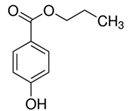 | 529.3 | 2.98 | 2.71 | 2.51 | 6.37 × 10−9 | 8.2/ neutral | (2); (3); Petrie et al. [40] |
| Insect repellents | |||||||||
| N,N-diethyl-meta-toluamide/ 191.3 | C12H17NO |  | 912 | 2.18 | 1.76 | 2.50 | 2.10 × 10−8 | 0.7/ neutral | (2); Conkle et al. [63]; Anumol et al. [64]; Li et al. [21]; Yi et al. [5]; Sgroi et al. [20] |
| Antiseptics | |||||||||
| Triclosan/ 289.55 | C12H7Cl3O2 |  | 10 | 5.34 | 4.26 | 4.76 | 2.13 × 10−8 | 7.9/ neutral; negative | (2); Park et al. [50]; Verlicchi et al. [12,65]; Zhang et al. [11]; Zhu and Chen [25]; Carranza-Diaz et al. [41]; Dai et al. [30]; Li et al. [21]; Vystavna et al. [47]; Petrie et al. [40]; Wang et al. [45] |
| Triclocarban/ 315.6 | C13H9Cl3N2O |  | 0.11 | 4.90 | 3.73 | 4.90 | 4.50 × 10−11 | 12.8/ neutral | (2); Zhu and Chen [25]; Anumol et al. [64]; Verlicchi et al. [12]; Chen et al. [26] |
| Fragrances | |||||||||
| Methyl dihydrojasmonate/ 226.31 | C13H22O3 | 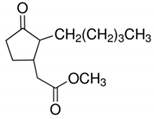 | 91.7 | 2.98 | 2.18 | NA | 5.02 × 10−7 | −6.9/ neutral | (2); (4) Hijosa-Valsero et al. [14,15,54]; Reyes-Contreras et al. [16]; Zhang et al. [11]; Verlicchi et al. [12] |
| Cashmeran/ 206.33 | C14H22O | 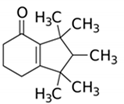 | 5.94 | 4.49 | 3.60 | NA | 1.42 × 10−4 | −5.1/ neutral | (2); (3); (5); Hijosa-Valsero et al. [14]; Verlicchi et al. [12] |
| Galaxolide/ 258.4 | C18H26O |  | 1.75 | 6.26 | 4.10 | NA | 1.32 × 10−4 | 8.24/ neutral | (2); (3); Hijosa-Valsero et al. [14,15,54]; Reyes-Contreras et al. [16]; Zhang et al. [11]; Verlicchi et al. [12] |
| Tonalide/ 258.41 | C18H26O | 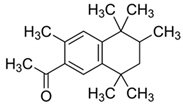 | 1.25 | 6.35 | 4.27 | 5.80 | 4.22 × 10−5 | 16/ neutral | (2); (3); Ávila et al. [66]; Hijosa-Valsero et al. [14,15,54]; Reyes-Contreras et al. [16]; Zhang et al. [11]; Verlicchi et al. [12] |
| Flame retardants | |||||||||
| Tributyl phosphate/ 266.32 | C12H27O4P |  | 280 | 4.00 | 3.24 | NA | 3.19 × 10−6 | 19/ neutral | (2); (3); Bergman et al. [67] |
| Triphenyl phosphate/ 326.29 | C18H15O4P | 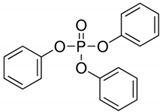 | 1.9 | 4.70 | 3.24 | NA | 3.98 × 10−8 | 16.4/ neutral | (2); (3); Brooke et al. [68] |
| Tris (2-chloroethyl) phosphate/ 285.48 | C6H12Cl3O4P | 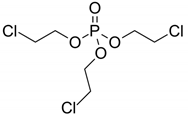 | 7.82 × 103 | 1.63 | 2.48 | NA | 2.55 × 10−8 | 16.1/ neutral | (3); (6); (7); Xu et al. [69] |
| Sunscreen agents | |||||||||
| Oxybenzone/ 228.25 | C14H12O3 |  | 68.6 | 3.52 | 2.63 | 3.06 | 1.50 × 10−8 | 7.92/ neutral | (2); (3); (7); Zhang et al. [11]; Verlicchi et al. [12]; Petrie et al. [40] |
| Sulisobenzone/ 308.31 | C14H12O6S | 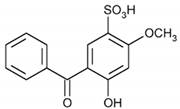 | 2.03 × 104 | 0.37 | 1.55 | −0.53 | 7.06 × 10−15 | 1.99/ negative | (2); (3); (8); Petrie et al. [40] |
3.4. Statistical Comparison of Different Types of CWs for PCPs Removal
3.5. Effect of Artificial Aeration (AA) on the Removal of PCPs
4. Future Research Needs
- More research should be undertaken to investigate the occurrence of PCPs in water resources and the environment, especially for those PCPs which are classified under high and medium risk categories (i.e., triclosan, methylparaben, galaxolide, oxybenzone, and methyl dihydrojasmonate). Furthermore, more emphasis should be given to examine the impact of these PCPs on human and ecosystem health.
- The HCW showed better performance compared with individual systems (e.g., VFCW, HFCW, and FWSCW), which shows the high potential for this type of CW for practical applications for the treatment of wastewater containing PCPs. Nevertheless, different types of HCWs are investigated such as FWSCW + FWSCW, HFCW + HFCW, VFCW + VFCW, VFCW + HFCW, HCW including FWSCW, and also multistage of more than two types of CWs. Therefore, further research is needed to develop the best possible integrated design of CWs to ensure the occurrence of various removal processes, which are necessary to remove multiple types of PCPs.
- The water flow rate at both inflow and outflow should be measured to quantify the effect of evapotranspiration on the removal efficiency estimates of PCPs in different types of CWs.
- The establishment of various micro-environments (aerobic and anaerobic conditions) in CWs by the application of AA, provides both aerobic and anaerobic metabolic pathways contributing to the removal of PCPs. However, to date, the application of AA has been considered by a very limited number of studies, which highlights the need for further research. In addition, more research is needed to investigate which type of aeration (e.g., intermittent or continuous) would be beneficial to generate such conditions to improve the performance of CWs.
5. Conclusions
- The CWs contributed considerably in reducing the environmental risks posed by PCPs. Although the risk is not fully abolished by CWs, it is significantly reduced in most cases. Our analysis of global data classified triclosan under high risk category, whereas, triclocarban, methylparaben, galaxolide, oxybenzone, and methyl dihydrojasmonate were grouped under medium risk category. These high to medium risk PCPs are recommended to be considered for regulatory monitoring, control and water quality standard formulation purposes.
- CWs could effectively remove a large number of PCPs from wastewater, and all of the 15 widely studied compounds show a positive removal efficiency ranging from 9.0% to 84%. In most of the examined PCPs, adsorption and/or sorption is the most dominant removal mechanism (8 out of 15) followed by biodegradation (aerobic and anaerobic) (5 out of 15) and plant uptake (planted CWs) (3 out of 15), and the physicochemical properties of PCPs play a pivotal role in their removal processes.
- The six selected PCPs, which were studied by more than two types of CWs, demonstrate a moderate to high potential for successful treatment. Among the studied CWs, the HCW performed better for most of the examined PCPs followed by VFCW, HFCW, and FWSCW. The superior performance of HCW could be mainly attributed to the co-existence of aerobic and anaerobic conditions, and longer HRT that is beneficial for the removal of PCPs (e.g., triclosan, methyl dihydrojasmonate, galaxolide, tonalide, and oxybenzone), which are removed under both conditions and by adsorption and/or sorption processes. Aerobic biodegradation being more efficient than anaerobic explains the better removal efficiency in VFCW compared with HFCW. In FWSCW, photodegradation is the main removal pathway and only few PCPs (e.g., methylparaben, propylparaben, triclosan, and tonalide) demonstrated considerable removal by this process.
- The improvement in DO due to redox manipulation with AA enhances the removal efficiency of PCPs, which are better removed under aerobic conditions. Although anoxic bio-transformations are slower than the oxic ones, the high performance of AA-CWs could be due to the occurrence of various micro-environments (aerobic and anaerobic) and subsequent contribution of both aerobic and anaerobic metabolic pathways in the removal of PCPs. This is evident by the enhanced removal efficiency in the case of AA-FWSCW (triclosan), AA-HFCW (acesulfame), and AA-VFCW (triclosan, tonalide, oxybenzone, and acesulfame) compared with their corresponding NA-CWs.
Supplementary Materials
Author Contributions
Funding
Conflicts of Interest
References
- Nakada, N.; Kiri, K.; Shinohara, H.; Harada, A.; Kuroda, K.; Takizawa, S.; Takada, H. Evaluation of pharmaceuticals and personal care products as water-soluble molecular markers of sewage. Environ. Sci. Technol. 2008, 42, 6347–6353. [Google Scholar] [CrossRef] [PubMed]
- Suárez, S.; Carballa, M.; Omil, F.; Lema, J.M. How are pharmaceutical and personal care products (PPCPs) removed from urban wastewaters? Rev. Environ. Sci. Biotechnol. 2008, 7, 125–138. [Google Scholar] [CrossRef]
- Caliman, F.A.; Gavrilescu, M. Pharmaceuticals, personal care products and endocrine disrupting agents in the environment—A review. CLEAN–Soil Air Water 2009, 37, 277–303. [Google Scholar] [CrossRef]
- Luo, Y.; Guo, W.; Ngo, H.H.; Nghiem, L.D.; Hai, F.I.; Zhang, J.; Liang, S.; Wang, X.C. A review on the occurrence of micropollutants in the aquatic environment and their fate and removal during wastewater treatment. Sci. Total Environ. 2014, 473–474, 619–641. [Google Scholar] [CrossRef]
- Yi, X.; Tran, N.H.; Yin, T.; He, Y.; Gin, K.Y.-H. Removal of selected PPCPs, EDCs, and antibiotic resistance genes in landfill leachate by a full-scale constructed wetlands system. Water Res. 2017, 121, 46–60. [Google Scholar] [CrossRef]
- Tran, N.H.; Reinhard, M.; Gin, K.Y.-H. Occurrence and fate of emerging contaminants in municipal wastewater treatment plants from different geographical regions—A review. Water Res. 2018, 133, 182–207. [Google Scholar] [CrossRef]
- Tran, N.H.; Reinhard, M.; Khan, E.; Huiting, C.; Nguyen, V.T.; Li, Y.; Goh, S.G.; Nguyen, Q.B.; Saeidi, N.; Gin, K.Y.-H. Emerging contaminants in wastewater, stormwater runoff, and surface water: Application as chemical markers for diffuse sources. Sci. Total Environ. 2019, 676, 252–267. [Google Scholar] [CrossRef]
- Yin, T.; Tran, N.H.; Huiting, C.; He, Y.; Gin, K.Y.-H. Biotransformation of polyfluoroalkyl substances by microbial consortia from constructed wetlands under aerobic and anoxic conditions. Chemosphere 2019, 233, 101–109. [Google Scholar] [CrossRef]
- Gogoi, A.; Mazumder, P.; Tyagi, V.K.; Chaminda, G.G.T.; An, A.K.; Kumar, M. Occurrence and fate of emerging contaminants in water environment: A review. Groundw. Sustain. Dev. 2018, 6, 169–180. [Google Scholar] [CrossRef]
- Verlicchi, P.; Zambello, E. How efficient are constructed wetlands in removing pharmaceuticals from untreated and treated urban wastewaters? A review. Sci. Total Environ. 2014, 470–471, 1281–1306. [Google Scholar] [CrossRef]
- Zhang, D.; Gersberg, R.M.; Ng, W.J.; Tan, S.K. Removal of pharmaceuticals and personal care products in aquatic plant-based systems: A review. Environ. Pollut. 2014, 184, 620–639. [Google Scholar] [CrossRef] [PubMed]
- Verlicchi, P.; Zambello, E.; Aukidy, M.A. Removal of Personal Care Products in Constructed Wetlands. In Personal Care Products in the Aquatic Environment; Díaz-Cruz, M.S., Barcelό, D., Eds.; The Handbook of Environmental Chemistry; Springer: Cham, Switzerland, 2015; Volume 36, pp. 319–354. [Google Scholar] [CrossRef]
- Vo, H.-N.-P.; Bui, X.-T.; Nguyen, T.-M.-H.; Koottatep, T.; Bandyopadhyay, A. Insights of the Removal Mechanisms of Pharmaceutical and Personal Care Products in Constructed Wetlands. Curr. Pollut. Rep. 2018, 4, 93–103. [Google Scholar] [CrossRef]
- Hijosa-Valsero, M.; Matamoros, V.; Sidrach-Cardona, R.; Martin-Villacorta, J.; Becares, E.; Bayona, J.M. Comprehensive assessment of the design configuration of constructed wetlands for the removal of pharmaceuticals and personal care products from urban wastewaters. Water Res. 2010, 44, 3669–3678. [Google Scholar] [CrossRef] [PubMed]
- Hijosa-Valsero, M.; Reyes-Contreras, C.; Domínguez, C.; Bécares, E.; Bayona, J.M. Behaviour of pharmaceuticals and personal care products in constructed wetland compartments: Influent, effluent, pore water, substrate and plant roots. Chemosphere 2016, 145, 508–517. [Google Scholar] [CrossRef] [PubMed]
- Reyes-Contreras, C.; Hijosa-Valsero, M.; Sidrach-Cardona, R.; Bayona, J.M.; Bécares, E. Temporal evolution in PPCP removal from urban wastewater by constructed wetlands of different configuration: A medium-term study. Chemosphere 2012, 88, 161–167. [Google Scholar] [CrossRef] [PubMed]
- Kahl, S.; Nivala, J.; Afferden, M.V.; Müller, R.A.; Reemtsma, T. Effect of design and operational conditions on the performance of subsurface flow treatment wetlands: Emerging organic contaminants as indicators. Water Res. 2017, 125, 490–500. [Google Scholar] [CrossRef]
- Nivala, J.; Kahl, S.; Boog, J.; Afferden, M.; Reemtsma, T.; Müller, R.A. Dynamics of emerging organic contaminant removal in conventional and intensified subsurface flow treatment wetlands. Sci. Total Environ. 2019, 649, 1144–1156. [Google Scholar] [CrossRef]
- Matamoros, V.; Arias, C.; Brix, H.; Bayona, J.M. Removal of pharmaceuticals and personal care products (PPCPs) from urban wastewater in a pilot vertical flow constructed wetland and a sand filter. Environ. Sci. Technol. 2007, 41, 8171–8177. [Google Scholar] [CrossRef]
- Sgroi, M.; Pelissari, C.; Roccaro, P.; Sezerino, P.H.; García, J.; Vagliasindi, F.G.A.; Ávila, C. Removal of organic carbon, nitrogen, emerging contaminants and fluorescing organic matter in different constructed wetland configurations. Chem. Eng. J. 2018, 332, 619–627. [Google Scholar] [CrossRef]
- Li, J.; Zhou, Q.; Campos, L.C. Removal of selected emerging PPCP compounds using greater duckweed (Spirodela polyrhiza) based lab-scale free water constructed wetland. Water Res. 2017, 126, 252–261. [Google Scholar] [CrossRef]
- Ávila, C.; Nivala, J.; Olsson, L.; Kassa, K.; Headley, T.; Mueller, R.A.; Bayona, J.M.; García, J. Emerging organic contaminants in vertical subsurface flow constructed wetlands: Influence of media size, loading frequency and use of active aeration. Sci. Total Environ. 2014, 494–495, 211–217. [Google Scholar] [CrossRef] [PubMed]
- Hernando, M.D.; Mezcua, M.; Fernández-Alba, A.R.; Barceló, D. Environmental risk assessment of pharmaceutical residues in wastewater effluents, surface waters and sediments. Talanta 2006, 69, 334–342. [Google Scholar] [CrossRef] [PubMed]
- Kosma, C.I.; Lambropoulou, D.A.; Albanis, T.A. Investigation of PPCPs in wastewater treatment plants in Greece: Occurrence, removal and environmental risk assessment. Sci. Total Environ. 2014, 466–467, 421–438. [Google Scholar] [CrossRef] [PubMed]
- Zhu, S.; Chen, H. The fate and risk of selected pharmaceutical and personal care products in wastewater treatment plants and a pilot-scale multistage constructed wetland system. Environ. Sci. Pollut. Res. 2014, 21, 1466–1479. [Google Scholar] [CrossRef] [PubMed]
- Chen, Y.; Vymazal, J.; Březinová, T.; Koželuh, M.; Kule, L.; Huang, J.; Chen, Z. Occurrence, removal and environmental risk assessment of pharmaceuticals and personal care products in rural wastewater treatment wetlands. Sci. Total Environ. 2016, 566–567, 1660–1669. [Google Scholar] [CrossRef] [PubMed]
- Chen, J.; Liu, Y.-S.; Deng, W.-J.; Ying, G.-G. Removal of steroid hormones and biocides from rural wastewater by an integrated constructed wetland. Sci. Total Environ. 2019, 660, 358–365. [Google Scholar] [CrossRef] [PubMed]
- Matamoros, V.; Rodríguez, Y.; Albaigés, J. A comparative assessment of intensive and extensive wastewater treatment technologies for removing emerging contaminants in small communities. Water Res. 2016, 88, 777–785. [Google Scholar] [CrossRef] [PubMed]
- Matamoros, V.; Rodríguez, Y.; Bayona, J.M. Mitigation of emerging contaminants by full-scale horizontal flow constructed wetlands fed with secondary treated wastewater. Ecol. Eng. 2017, 99, 222–227. [Google Scholar] [CrossRef]
- Dai, Y.; Tao, R.; Tai, Y.; Tam, N.F.; Dan, A.; Yang, Y. Application of a full-scale newly developed stacked constructed wetland and an assembled bio-filter for reducing phenolic endocrine disrupting chemicals from secondary effluent. Ecol. Eng. 2017, 99, 496–503. [Google Scholar] [CrossRef]
- Vymazal, J.; Březinová, T.D.; Koželuh, M.; Kule, L. Occurrence and removal of pharmaceuticals in four full-scale constructed wetlands in the Czech Republic—The first year of monitoring. Ecol. Eng. 2017, 98, 354–364. [Google Scholar] [CrossRef]
- Yamamoto, H.; Tamura, I.; Hirata, Y.; Kato, J.; Kagota, K.; Katsuki, S.; Yamamoto, A.; Kagami, Y.; Tatarazako, N. Aquatic toxicity and ecological risk assessment of seven parabens: Individual and additive approach. Sci. Total Environ. 2011, 410–411, 102–111. [Google Scholar] [CrossRef] [PubMed]
- Brausch, J.M.; Rand, G.M. A review of personal care products in the aquatic environment: Environmental concentrations and toxicity. Chemosphere 2011, 82, 1518–1532. [Google Scholar] [CrossRef] [PubMed]
- Balk, F.; Ford, R.A. Environmental risk assessment for the polycyclic musks, AHTN and HHCB: II. Effect assessment and risk characterisation. Toxicol. Lett. 1999, 111, 81–94. [Google Scholar] [CrossRef]
- Cristale, J.; Vázquez, A.G.; Barata, C.; Lacorte, S. Priority and emerging flame retardants in rivers: Occurrence in water and sediment, Daphnia magna toxicity and risk assessment. Environ. Int. 2013, 59, 232–243. [Google Scholar] [CrossRef] [PubMed]
- Matamoros, V.; Nguyen, L.X.; Arias, C.A.; Salvadó, V.; Brix, H. Evaluation of aquatic plants for removing polar microcontaminants: A microcosm experiment. Chemosphere 2012, 88, 1257–1264. [Google Scholar] [CrossRef] [PubMed]
- Dordio, A.V.; Candeias, A.J.E.; Pinto, A.P.; da Costa, C.T.; Carvalho, A.J.P. Preliminary media screening for application in the removal of clofibric acid, carbamazepine and ibuprofen by SSF-constructed wetlands. Ecol. Eng. 2009, 35, 290–302. [Google Scholar] [CrossRef]
- Dordio, A.V.; Carvalho, A.J.P.; Teixeira, D.M.; Dias, C.B.; Pinto, A.P. Removal of pharmaceuticals in microcosm constructed wetlands using Typha Spp. and LECA. Bioresour. Technol. 2010, 101, 886–892. [Google Scholar] [CrossRef]
- Anjos, M.L.; Isique, W.D.; Albertin, L.L.; Matsumoto, T.; Henares, M.N.P. Parabens Removal from Domestic Sewage by Free-Floating Aquatic Macrophytes. Waste Biomass Valor. 2019, 10, 2221–2226. [Google Scholar] [CrossRef]
- Petrie, B.; Rood, S.; Smith, B.D.; Proctor, K.; Youdan, J.; Barden, R.; Kasprzyk-Hordern, B. Biotic phase micropollutant distribution in horizontal sub-surface flow constructed wetlands. Sci. Total Environ. 2018, 630, 648–657. [Google Scholar] [CrossRef]
- Carranza-Diaz, O.; Schultze-Nobre, L.; Moeder, M.; Nivala, J.; Kuschk, P.; Koeser, H. Removal of selected organic micropollutants in planted and unplanted pilot-scale horizontal flow constructed wetlands under conditions of high organic load. Ecol. Eng. 2014, 71, 234–245. [Google Scholar] [CrossRef]
- Liu, J.; Wang, J.; Zhao, C.; Hay, A.G.; Xie, H.; Zhan, J. Triclosan removal in wetlands constructed with different aquatic plants. Appl. Microbiol. Biotechnol. 2016, 100, 1459–1467. [Google Scholar] [CrossRef] [PubMed]
- Xie, H.; Yang, Y.; Liu, J.; Kang, Y.; Zhang, J.; Hu, Z.; Liang, S. Enhanced triclosan and nutrient removal performance in vertical up-flow constructed wetlands with manganese oxides. Water Res. 2018, 143, 457–466. [Google Scholar] [CrossRef] [PubMed]
- Button, M.; Cosway, K.; Sui, J.; Weber, K. Impacts and fate of triclosan and sulfamethoxazole in intensified re-circulating vertical flow constructed wetlands. Sci. Total Environ. 2019, 649, 1017–1028. [Google Scholar] [CrossRef] [PubMed]
- Wang, Y.; Yin, T.; Kelly, B.C.; Gin, K.Y.-H. Bioaccumulation behaviour of pharmaceuticals and personal care products in a constructed wetland. Chemosphere 2019, 222, 275–285. [Google Scholar] [CrossRef] [PubMed]
- Ávila, C.; Matamoros, V.; Reyes-Contreras, C.; Piña, B.; Casado, M.; Mita, L.; Rivetti, C.; Barata, C.; García, J.; Bayona, J.M. Attenuation of emerging contaminants in a hybrid constructed wetland system under different hydraulic loading rates and their associated toxicological effects in wastewater. Sci. Total Environ. 2014, 470–471, 1272–1280. [Google Scholar] [CrossRef] [PubMed]
- Vystavna, Y.; Frkova, Z.; Marchand, L.; Vergeles, Y.; Stolberg, F. Removal efficiency of pharmaceuticals in a full scale constructed wetland in East Ukraine. Ecol. Eng. 2017, 108 Pt A, 50–58. [Google Scholar] [CrossRef]
- Ávila, C.; Bayona, J.M.; Martín, I.; Salas, J.J.; García, J. Emerging organic contaminant removal in a full-scale hybrid constructed wetland system for wastewater treatment and reuse. Ecol. Eng. 2015, 80, 108–116. [Google Scholar] [CrossRef]
- Zhao, C.; Xie, H.; Xu, J.; Xu, X.; Zhang, J.; Hu, Z.; Liu, C.; Liang, S.; Wang, Q.; Wang, J. Bacterial community variation and microbial mechanism of triclosan (TCS) removal by constructed wetlands with different types of plants. Sci. Total Environ. 2015, 505, 633–639. [Google Scholar] [CrossRef]
- Park, N.; Vanderford, B.J.; Snyder, S.A.; Sarp, S.; Kim, S.D.; Cho, J. Effective controls of micro-pollutants included in wastewater effluent using constructed wetlands under anoxic condition. Ecol. Eng. 2009, 35, 418–423. [Google Scholar] [CrossRef]
- Matamoros, V.; Salvadó, V. Evaluation of the seasonal performance of a water reclamation pond-constructed wetland system for removing emerging contaminants. Chemosphere 2012, 86, 111–117. [Google Scholar] [CrossRef]
- Francini, A.; Mariotti, L.; Gregorio, S.D.; Sebastiani, L.; Andreucci, A. Removal of micro-pollutants from urban wastewater by constructed wetlands with Phragmites australis and Salix matsudana. Environ. Sci. Pollut. Res. 2018, 25, 36474–36484. [Google Scholar] [CrossRef] [PubMed]
- Hijosa-Valsero, M.; Matamoros, V.; Martin-Villacorta, J.; Becares, E.; Bayona, J.M. Assessment of full-scale natural systems for the removal of PPCPs from wastewater in small communities. Water Res. 2010, 44, 1429–1439. [Google Scholar] [CrossRef]
- Hijosa-Valsero, M.; Matamoros, V.; Pedescoll, A.; Martín-Villacorta, J.; Bécares, E.; García, J.; Bayona, J.M. Evaluation of primary treatment and loading regimes in the removal of pharmaceuticals and personal care products from urban wastewaters by subsurface-flow constructed wetlands. Int. J. Environ. Anal. Chem. 2011, 91, 632–653. [Google Scholar] [CrossRef]
- Salcedo, J.J.P.; Montes, G.H.E.; Frómeta, A.E.N.; Osorio, A.C.; Negrete, J.M. Removal of Organic Micropollutants from Riverine Waters using Constructed Wetlands: A Mesocosms Experiment. Int. J. Appl. Eng. Res. 2018, 13, 15740–15748. [Google Scholar]
- Matamoros, V.; Bayona, J.M. Elimination of pharmaceuticals and personal care products in subsurface flow constructed wetlands. Environ. Sci. Technol. 2006, 40, 5811–5816. [Google Scholar] [CrossRef] [PubMed]
- Ávila, C.; Reyes, C.; Bayona, J.M.; García, J. Emerging organic contaminant removal depending on primary treatment and operational strategy in horizontal subsurface flow constructed wetlands: Influence of redox. Water Res. 2013, 47, 315–325. [Google Scholar] [CrossRef] [PubMed]
- Nuel, M.; Laurent, J.; Bois, P.; Heintz, D.; Wanko, A. Seasonal and ageing effect on the behaviour of 86 drugs in a full-scale surface treatment wetland: Removal efficiencies and distribution in plants and sediments. Sci. Total Environ. 2018, 615, 1099–1109. [Google Scholar] [CrossRef]
- Berglund, B.; Khan, G.A.; Weisner, S.E.B.; Ehde, P.M.; Fick, J.; Lindgren, P.-E. Efficient removal of antibiotics in surface-flow constructed wetlands, with no observed impact on antibiotic resistance genes. Sci. Total Environ. 2014, 476–477, 29–37. [Google Scholar] [CrossRef]
- Matamoros, V.; García, J.; Bayona, J.M. Organic micropollutant removal in a full-scale surface flow constructed wetland fed with secondary effluent. Water Res. 2008, 42, 653–660. [Google Scholar] [CrossRef]
- Zou, H.; Radke, M.; Kierkegaard, A.; MacLeod, M.; McLachlan, M.S. Using chemical benchmarking to determine the persistence of chemicals in a Swedish Lake. Environ. Sci. Technol. 2015, 49, 1646–1653. [Google Scholar] [CrossRef]
- Magnuson, B.A.; Carakostas, M.C.; Moore, N.H.; Poulos, S.P.; Renwick., A.G. Biological fate of low-calorie sweeteners. Nutr. Rev. 2016, 74, 670–689. [Google Scholar] [CrossRef] [PubMed]
- Conkle, J.L.; Gan, J.; Anderson, M.A. Degradation and sorption of commonly detected PPCPs in wetland sediments under aerobic and anaerobic conditions. J. Soils Sediments 2012, 12, 1164–1173. [Google Scholar] [CrossRef]
- Anumol, T.; Sgroi, M.; Park, M.; Roccaro, P.; Snyder, S.A. Predicting trace organic compound breakthrough in granular activated carbon using fluorescence and UV absorbance as surrogates. Water Res. 2015, 76, 76–87. [Google Scholar] [CrossRef] [PubMed]
- Verlicchi, P.; Al Aukidy, M.; Zambello, E. Occurrence of pharmaceutical compounds in urban wastewater: Removal, mass load and environmental risk after a secondary treatment—A review. Sci. Total Environ. 2012, 429, 123–155. [Google Scholar] [CrossRef] [PubMed]
- Ávila, C.; Pedescoll, A.; Matamoros, V.; Bayona, J.M.; García, J. Capacity of a horizontal subsurface flow constructed wetland system for the removal of emerging pollutants: An injection experiment. Chemosphere 2010, 81, 1137–1142. [Google Scholar] [CrossRef]
- Bergman, A.; Rydén, A.; Law, R.J.; de Boer, J.; Covaci, A.; Alaee, M.; Birnbaum, L.; Petreas, M.; Rose, M.; Sakai, S.; et al. A novel abbreviation standard for organobromine, organochlorine and organophosphorus flame retardants and some characteristics of the chemicals. Environ. Int. 2012, 49, 57–82. [Google Scholar] [CrossRef] [PubMed]
- Brooke, D.N.; Crookes, M.J.; Quarterman, P.; Burns, S. Environmental Risk Evaluation Report: Triphenyl Phosphate (CAS No. 115-86-6). 2009. Available online: https://assets.publishing.service.gov.uk/government/uploads/.../scho0809bquk-e-e.pdf (accessed on 11 May 2019).
- Xu, T.; Li, P.; Wu, S.; Lei, L.; He, D. Tris (2-chloroethyl) phosphate (TCEP) and tris (2-chloropropyl) phosphate (TCPP) induce locomotor deficits and dopaminergic degeneration in Caenorhabditis elegans. Toxicol. Res. 2017, 6, 63–72. [Google Scholar] [CrossRef]
- Ilyas, H.; van Hullebusch, E.D. The influence of design and operational factors on the removal of personal care products by constructed wetlands. Water, under review.
- Białowiec, A.; Albuquerque, A.; Randerson, P.F. The influence of evapotranspiration on vertical flow subsurface constructed wetland performance. Ecol. Eng. 2014, 67, 89–94. [Google Scholar] [CrossRef]
- Zapater-Pereyra, M.; Ilyas, H.; Lavrnic, S.; van Bruggen, J.J.A.; Lens, P.N.L. Evaluation of the performance and space requirement by three different hybrid constructed wetlands in a stack arrangement. Ecol. Eng. 2015, 82, 290–300. [Google Scholar] [CrossRef]
- Ilyas, H.; Masih, I. The performance of the intensified constructed wetlands for organic matter and nitrogen removal: A review. J. Environ. Manag. 2017, 198, 372–383. [Google Scholar] [CrossRef] [PubMed]
- Ilyas, H.; Masih, I. The effects of different aeration strategies on the performance of constructed wetlands for phosphorus removal. Environ. Sci. Pollut. Res. 2018, 25, 5318–5335. [Google Scholar] [CrossRef] [PubMed]
- Ilyas, H.; Masih, I. Intensification of constructed wetlands for land area reduction: A review. Environ. Sci. Pollut. Res. 2017, 24, 12081–12091. [Google Scholar] [CrossRef] [PubMed]
- Matamoros, V.; Caselles-Osorio, A.; García, J.; Bayona, J.M. Behaviour of pharmaceutical products and biodegradation intermediates in horizontal subsurface flow constructed wetland. A microcosm experiment. Sci. Total Environ. 2008, 394, 171–176. [Google Scholar] [CrossRef] [PubMed]
- Imfeld, G.; Braeckevelt, M.; Kuschk, P.; Richnow, H.H. Monitoring and assessing processes of organic chemicals removal in constructed wetlands, a review. Chemosphere 2009, 74, 349–362. [Google Scholar] [CrossRef]
- Huang, Y.M.; Latorre, A.; Barcelo, D.; Garcia, J.; Aguirre, P.; Mujeriego, R.; Bayona, J.M. Factors affecting linear alkylbenzene sulfonates removal in subsurface flow constructed wetlands. Environ. Sci. Technol. 2004, 38, 2657–2663. [Google Scholar] [CrossRef] [PubMed]
- Matamoros, V.; García, J.; Bayona, J.M. Behavior of selected pharmaceuticals in subsurface flow constructed wetlands: A pilot-scale study. Environ. Sci. Technol. 2005, 39, 5449–5454. [Google Scholar] [CrossRef]
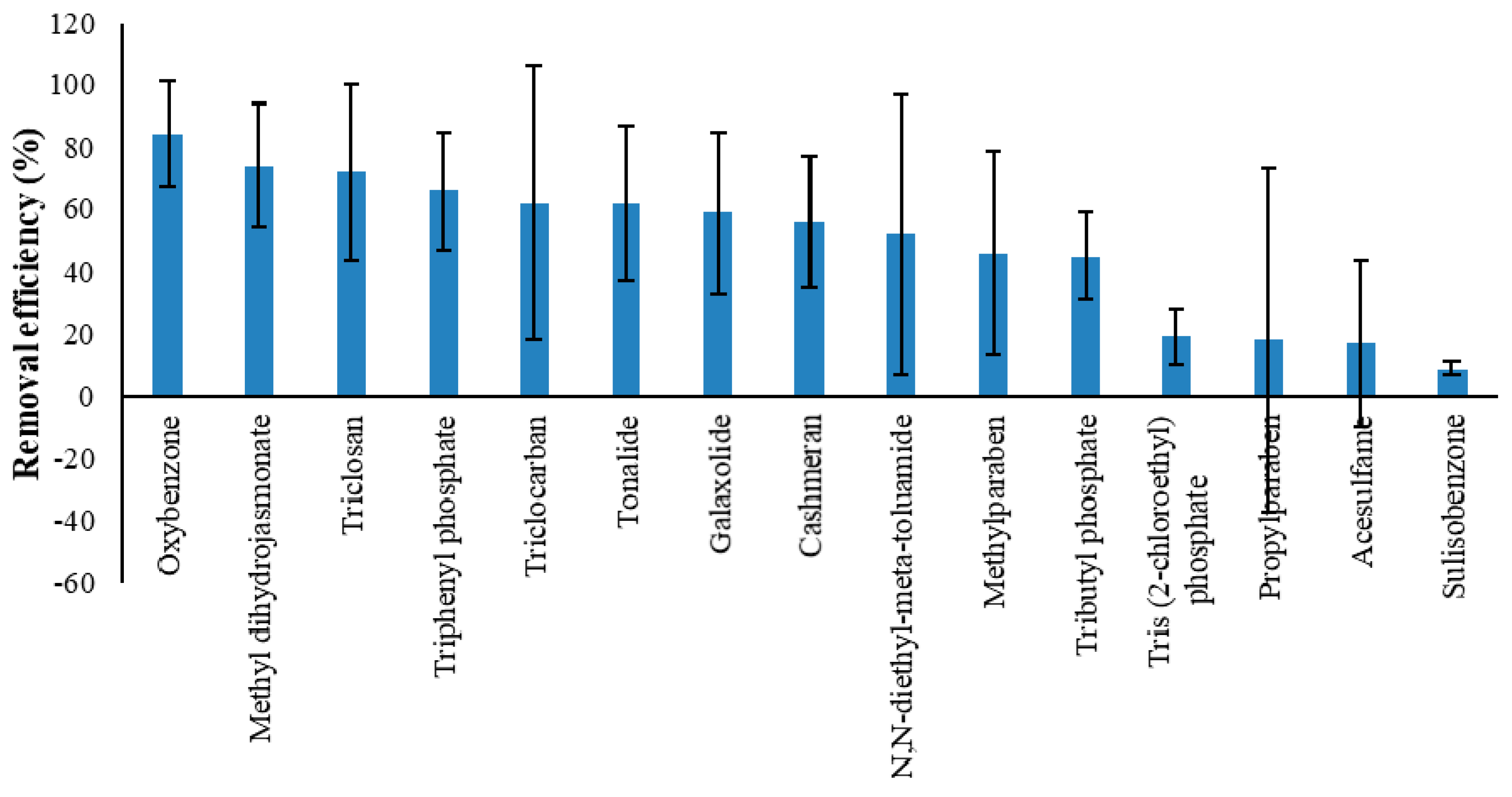
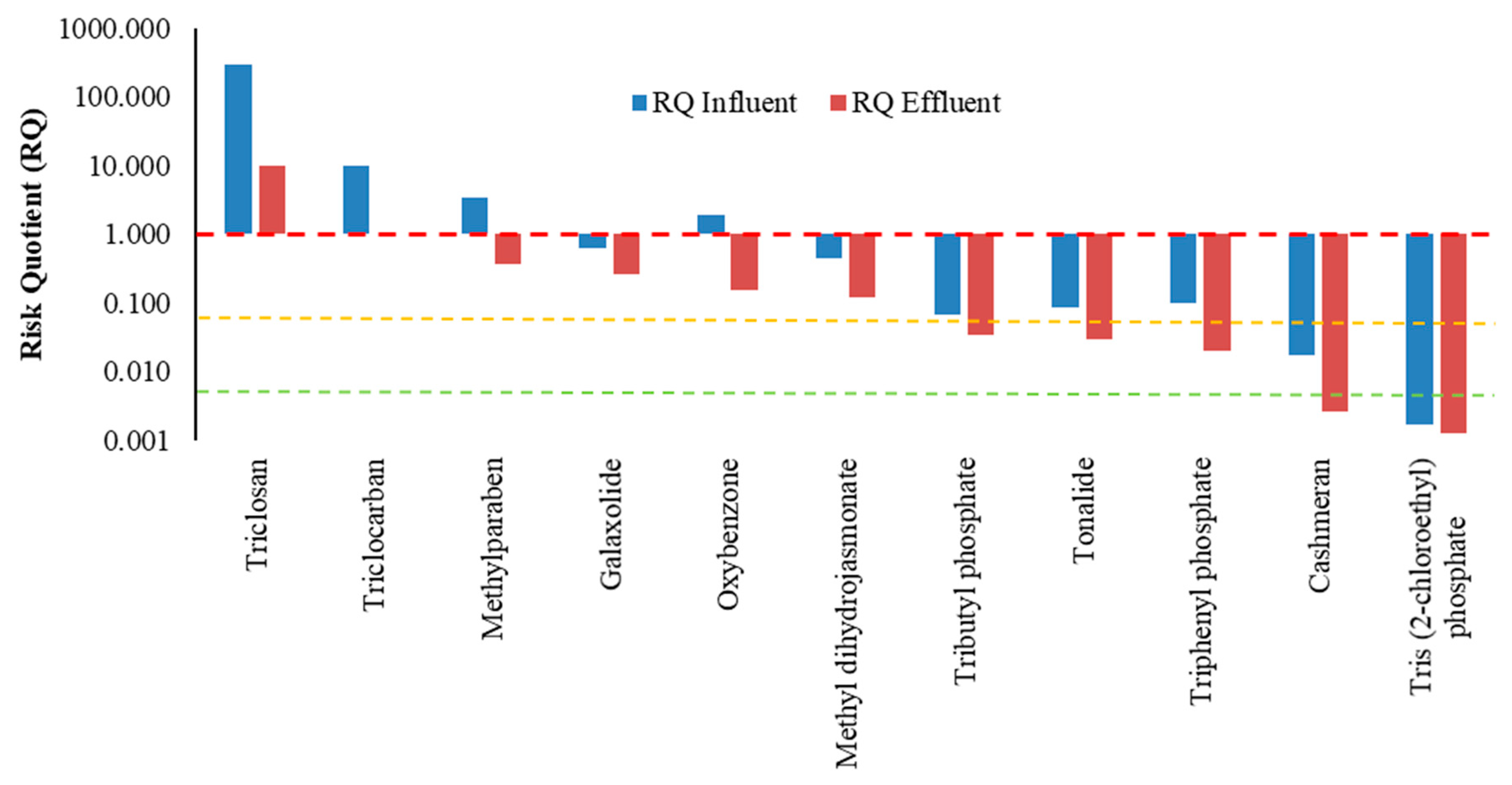

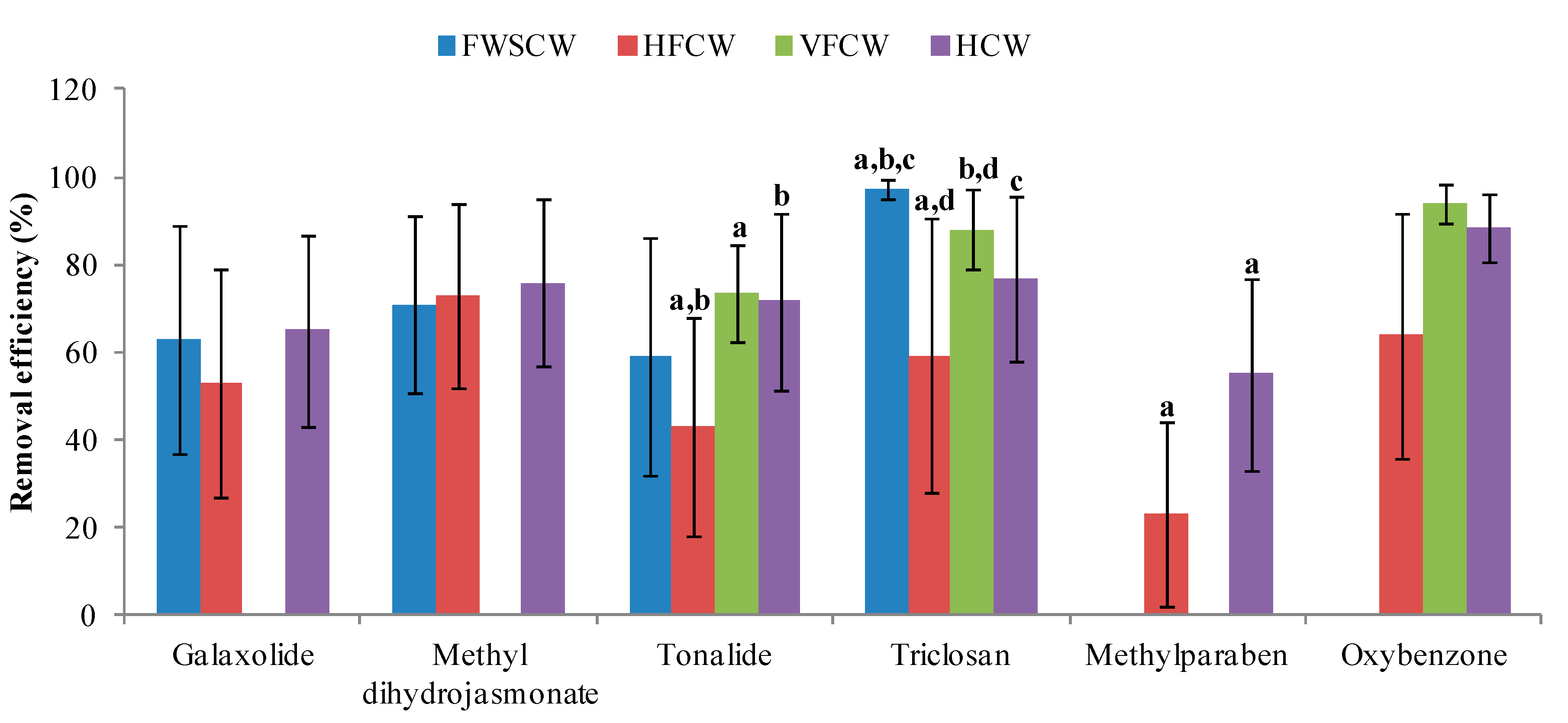
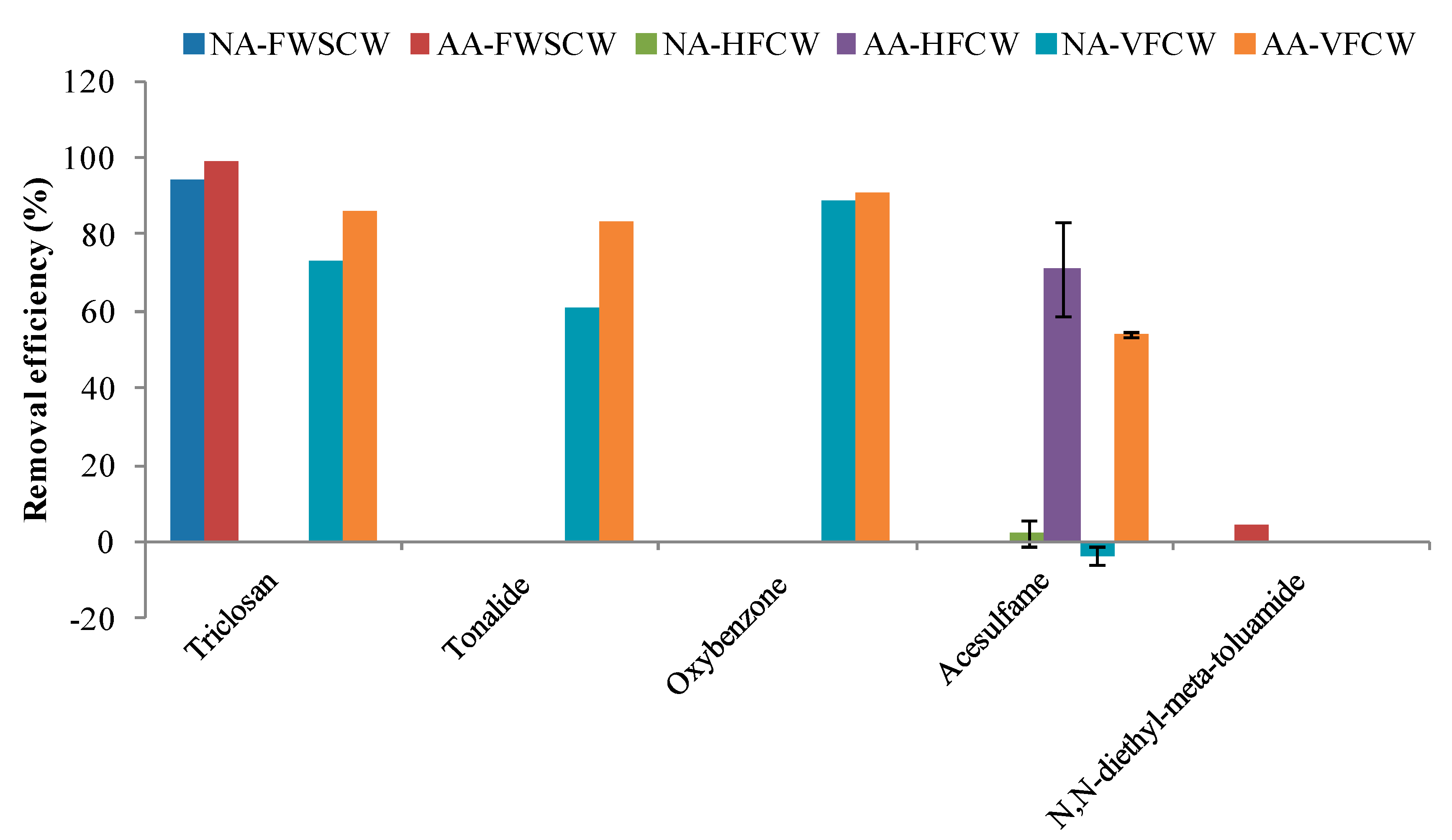
| No. of Categories | Category | Personal Care Products |
|---|---|---|
| 1 | Artificial sweeteners | Sucralose, Acesulfame |
| 2 | Preservatives | Methylparaben, Propylparaben |
| 3 | Insect repellents | N,N-diethyl-3-methyl benzoylamide, N,N-diethyl-3-methyl benzamide, N,N-diethyl-meta-toluamide |
| 4 | Antiseptics | Triclosan, Triclocarban |
| 5 | Fragrances | Cashmeran, Celestolide, Galaxolide, Methyl dihydrojasmonate, Tonalide |
| 6 | Flame retardants | Tributyl phosphate, Triphenyl phosphate, Tris (2-chloroethyl) phosphate |
| 7 | Sunscreen agents | Hydrocinnamic acid, Oxybenzone, Sulisobenzone |
| Class/PCPs | PNEC (μg L−1) | (MEC) Influent Conc. (μg L−1) | (MEC) Effluent Conc. (μg L−1) | Influent RQ | Effluent RQ | Risk Rank * Influent/ Effluent | References for PNEC Values |
|---|---|---|---|---|---|---|---|
| Preservatives | |||||||
| Methylparaben | 11.2 | 39 | 4.2 | 3.5 | 0.4 | High/ Medium | Yamamoto et al. [32] |
| Antiseptics | |||||||
| Triclosan | 0.13 | 39 | 1.3 | 300 | 10 | High/ High | Kosma et al. [24]; Zhu and Chen [25] |
| Triclocarban | 0.01 | 0.1 | 0.01 | 10 | 1.0 | High/ Medium | Zhu and Chen [25] |
| Fragrances | |||||||
| Methyl dihydro-jasmonate | 15.8 | 7.1 | 1.9 | 0.4 | 0.1 | Medium/ Medium | Matamoros et al. [28] |
| Cashmeran | 11.6 | 0.2 | 0.03 | 0.02 | 0.003 | Low/No | Brausch and Rand [33] |
| Galaxolide | 3.5 | 2.2 | 0.9 | 0.6 | 0.3 | Medium/ Medium | Balk and Ford [34] |
| Tonalide | 6.8 | 0.6 | 0.2 | 0.09 | 0.03 | Low/Low | Balk and Ford [34] |
| Flame retardants | |||||||
| Tributyl phosphate | 5.8 | 0.4 | 0.2 | 0.07 | 0.03 | Low/Low | Cristale et al. [35] |
| Triphenyl phosphate | 1.0 | 0.1 | 0.02 | 0.10 | 0.02 | Medium/ Low | Cristale et al. [35] |
| Tris (2-chloroethyl) phosphate | 235 | 0.4 | 0.3 | 0.002 | 0.001 | No/No | Cristale et al. [35] |
| Sunscreen agents | |||||||
| Oxybenzone | 1.9 | 3.6 | 0.3 | 1.9 | 0.2 | High/ Medium | Brausch and Rand [33] |
© 2020 by the authors. Licensee MDPI, Basel, Switzerland. This article is an open access article distributed under the terms and conditions of the Creative Commons Attribution (CC BY) license (http://creativecommons.org/licenses/by/4.0/).
Share and Cite
Ilyas, H.; van Hullebusch, E.D. Performance Comparison of Different Constructed Wetlands Designs for the Removal of Personal Care Products. Int. J. Environ. Res. Public Health 2020, 17, 3091. https://doi.org/10.3390/ijerph17093091
Ilyas H, van Hullebusch ED. Performance Comparison of Different Constructed Wetlands Designs for the Removal of Personal Care Products. International Journal of Environmental Research and Public Health. 2020; 17(9):3091. https://doi.org/10.3390/ijerph17093091
Chicago/Turabian StyleIlyas, Huma, and Eric D. van Hullebusch. 2020. "Performance Comparison of Different Constructed Wetlands Designs for the Removal of Personal Care Products" International Journal of Environmental Research and Public Health 17, no. 9: 3091. https://doi.org/10.3390/ijerph17093091
APA StyleIlyas, H., & van Hullebusch, E. D. (2020). Performance Comparison of Different Constructed Wetlands Designs for the Removal of Personal Care Products. International Journal of Environmental Research and Public Health, 17(9), 3091. https://doi.org/10.3390/ijerph17093091






